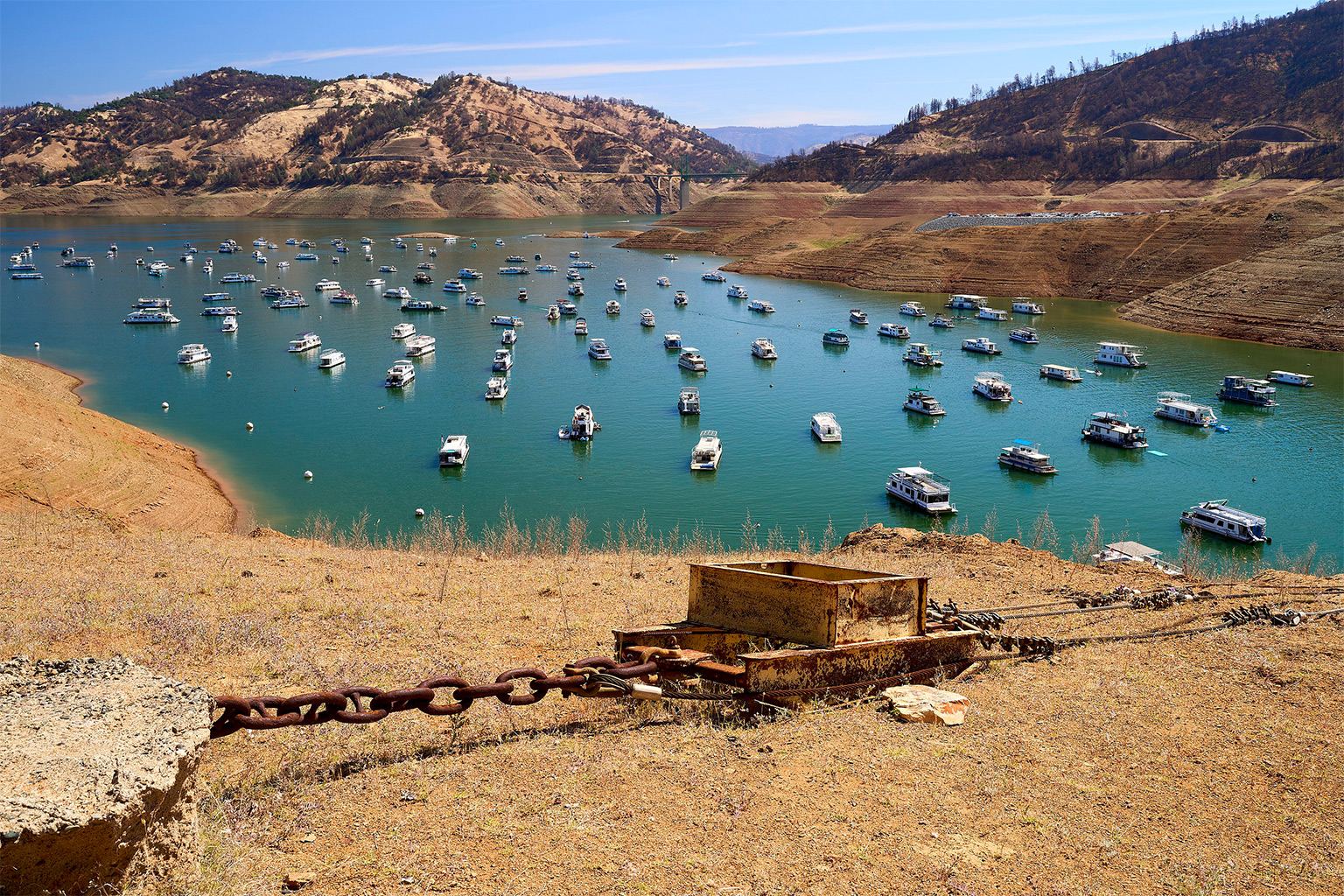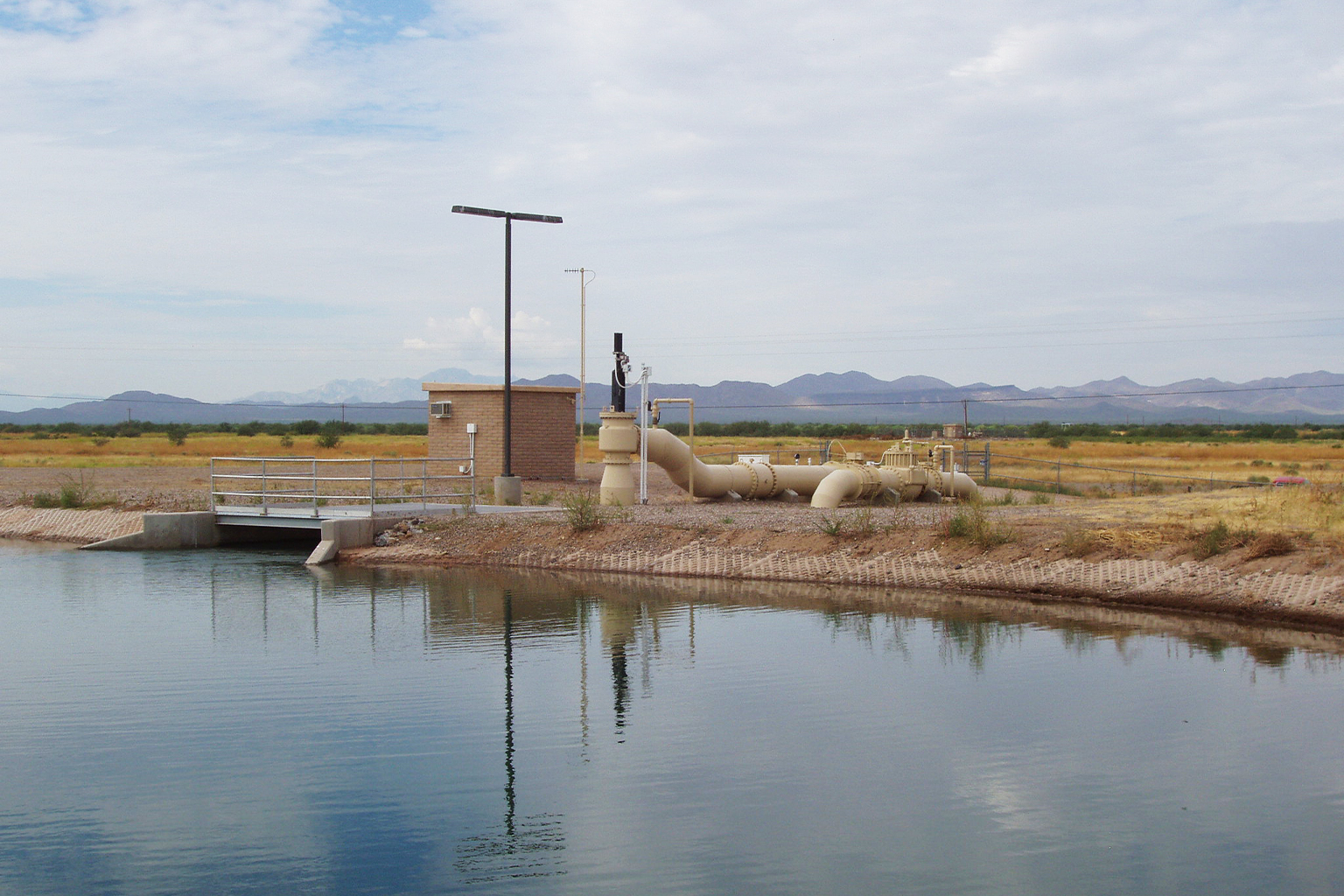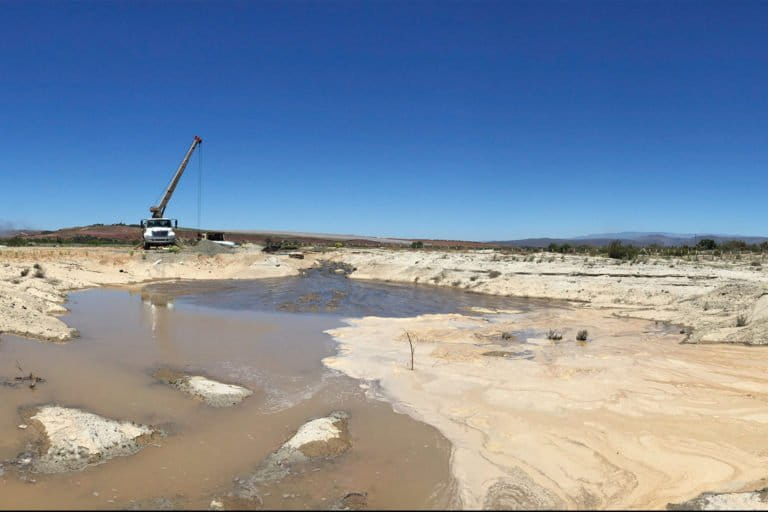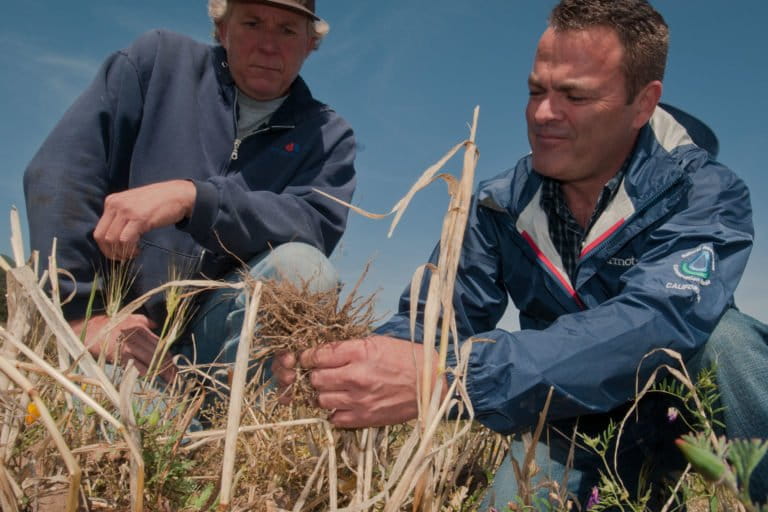- Drought in the U.S. West has been deepening for two decades, with no end in sight. Unfortunately for farmers, water use policies established in the early 20th century (a time of more plentiful rainfall), have left regulators struggling with their hands tied as they confront climate change challenges — especially intensifying drought.
- However, there is hope, as officials, communities and farmers strive to find innovative ways to save and more fairly share water. In Kansas and California, for example, new legislation has been passed to stave off dangerous groundwater declines threatening these states’ vital agricultural economies.
- Experts say that while an overhaul of the water allocation system in the West is needed, along with a coherent national water policy, extreme measures could be disruptive. But there are opportunities to realize incremental solutions now. Key among them is bridging a gap between federal water programs and farmers.
- A major concern is the trend toward single crop industrial agribusiness in semi-arid regions and the growing of water-intensive crops for export, such as corn and rice, which severely depletes groundwater. Ultimately, 20th century U.S. farm policies will need to yield to flexible 21st century policies that deal with unfolding climate change.
Extreme weather events exploded like bombs across the U.S. and around the globe in 2021, as record shattering heat waves, droughts and deluges left communities struggling to cope.
In addition to media stories highlighting destructive climate chaos in urban places — tropical storm flooded subways in New York; smoke choked Los Angeles; hurricane-born blackouts in New Orleans — an equally serious set of disasters broke upon U.S. rural places and upon the farmers, ranchers and agribusiness firms who grow America’s food.
These were slower moving and less dramatic — but no less dire or costly. Across the U.S. and Canadian High Plains, and in the American West, drought-challenged cattlemen this summer were making decisions to cull painstakingly-bred herds lacking water and feed. “That’s your future,” Manitoba farmer Dianne Riding told Reuters. “As my herd goes down, so does my income. It’s gut-wrenching.”
Future is, in this case, a prescient word: A reminder of the changed world that all but the most entrenched climate change deniers know is emerging, and that the legacy systems which undergird our agriculture — legal, economic and technological — must rapidly adapt to meet.


At present, however, herd cullings like those Ridings is doing, and extreme water rationing, are the most common kinds of reactive adaptation being practiced in the U.S. Midwest and West. In the absence of a coherent national plan, what’s happening now is mostly a mess of rushed emergency actions taken by stressed-out people, said Marcia Delonge of the Union of Concerned Scientists in a Mongabay interview. On December 1, for example, water agencies in drought-ravaged California reacted to intense drought conditions by informing 27 million residents and farmers on 750,000 acres that they won’t be getting any of the water they requested from the state heading into 2022.
“We have farmers needing to make changes that no one in their area had had to think about before,” DeLonge said, and they’re doing it “without the support they need.”
There are, however, effective ways of leveraging existing programs to get farmers more support, DeLonge added — which is fortunate, because if forecasts made in the most recent, August 2021, U.N. Intergovernmental Panel on Climate Change report are correct, the current climate for U.S. farming — harsh and volatile as it may already be — is as good, and likely far better, than what farmers and agribusiness can expect under even best case scenarios for the rest of the century.


Hard times coming
Drought has been stalking the U.S. West for 20 years now, but forecasts say dry times ahead will be worse. A recent U.N. assessment evaluated commitments by all the world’s nations to reduce their carbon emissions, and determined that those anemic pledges put us on the “catastrophic pathway” to 2.7° Celsius (nearly 5° Fahrenheit) of warming by 2100. Those elevated temperatures could result in the length of droughts increasing globally by an average of close to ten months, according to a study by Carbonbrief.
To make matters worse, another U.N. report released October 20 found that current fossil fuel production targets would release twice as much carbon as that required to keep warming below the crucial 1.5° C (2.7° F) increase set by the 2015 Paris Climate Agreement.
Even worse, that carbon is being pumped into an atmosphere that is likely to begin warming twice as fast over the next 25 years as the previous 50, according to leading climate scientist James Hansen. That speedier warming is thanks, ironically, to the global cleanup of sulfate aerosol atmospheric pollution — the source of a toxic haze that used to reflect solar heat back into space, but won’t any longer.
This means a grim reality for farmers in the already drought-besieged U.S. West, who need to prepare for intensifying heat waves, escalating relentless drought, and increasingly frequent, sudden gully-washer storms that wash parched soils away.

Farming in the West: Then and tomorrow
But a rapidly changing climate is only half the problem. What farmers and ranchers are facing today — and what consumers are facing as grocery store prices soar — is a rigid and antiquated U.S. water regulatory system that is struggling to adapt quickly to a fast altering climate.
A big part of the problem: The legal, financial and technological groundwork — and especially the water support infrastructure — that underpins farming in the American West today was pretty much laid down during the early 20th Century, a period when less extreme temperatures and more plentiful rainfalls predominated.
Agreements made in those wetter times have left us stuck with a legal regime which assumed that “water unused is water wasted,” explained Burke Griggs, a Washburn University natural resources law professor — an ever-more-obsolete “use it or lose it” ethic that resulted in profligate water use. State governments had “a statutory duty,” Griggs said, to assign both plentiful surface water and limited fossil groundwater to the “beneficial use” of growing annual crops and increasing farm yields — a policy inevitably leading over time to water waste and aquifer depletion.
On farm lands located above the long-troubled Ogallala Aquifer in the U.S. High Plains, for example, state boards “granted a lot more water rights than [the] aquifer could sustainably maintain,” Griggs said.
“The structural element of how the law works [in the U.S. Midwest and West], and the hydrological element of how groundwater works are in conflict,” he added.

That unsustainable water-use policy, combined with a revolution in aquifer-draining irrigation technology, made it possible to start growing thirsty crops like corn and rice in semi-desert U.S. regions. It also spawned an array of government crop subsidies and tax code additions that incentivized farmers to increase production and drain groundwater wrongly imagined to be limitless.
Farmers today, for example, can take tax write offs for both new highly efficient irrigation equipment, and then likewise for the groundwater depletion it causes — leading inevitably to exhaustion of the supply, Griggs explained.
In recent years, worsening U.S. drought has led to a partial wake-up call, as two very different states with two very different regional farming systems — Kansas and California — reacted with new legislation to stave off dangerous groundwater declines threatening their agriculture-dominated economies.
In Kansas, legislation that Griggs helped write, established Local Enhanced Management Areas (LEMAs), in which the state water engineer collaborates with farmers to ratchet down water use.
And in 2014, an alarmed California legislature passed the Sustainable Groundwater Management Act, requiring local and regional authorities to cooperate in the generational task of achieving groundwater sustainability in California by 2046.
This was a big change for a California legislative body that had spent more than a hundred years “letting pumpers in the Central Valley pump away,” Griggs said. “But 20 years of unprecedented drought gets the attention of the state legislature.”

Western reservoirs in trouble
Groundwater isn’t the only source put at risk by deepening drought. At the heart of far West water problems is the diminishment of the life-giving Colorado River, and its two immense reservoirs: Lake Mead and Lake Powell. Recent record declines of these water bodies due to alarming climate change have revealed long standing water mismanagement issues.
The reservoirs may have been “doomed,” from the first, Colorado State Assistant Climatologist Becky Bollinger wrote in the Washington Post: The legal compact that the two reservoirs were built to ensure — and that is now failing under the stress of intensifying heat and drought — was signed in 1922, at the end of “a relatively wet decade,” leading to water allocations that were “higher than they should have been,” and established legal rights to water allocations that are now difficult or impossible to fulfill.
But there is good news here: These are solvable problems, if officials, communities and farmers think in terms of building flexibility and cooperation into existing water systems — rather than shooting for rapid, revolutionary change, which tends to trigger gridlock, said Ellen Hanak, director of water policy at the Public Policy Institute of California.
Western states have experimented with new Colorado River political solutions, Hanak added: letting states “collaborate to keep water stored in Lake Mead instead of using it,” allowing for “carryover storage” to move states beyond the “use it or lose it trap,” or simply paying agricultural producers not to produce.

Arizona, California and Nevada, for example, are moving forward with a plan to cooperate in saving 500,000 acre-feet of water in Lake Mead annually through 2026. Elsewhere, in California’s Palo Verde inland irrigation district, farmer cooperatives are collaborating to “rotationally fallow” their fields, which allows a steady crop production flow even as farmers sell their saved water to thirsty Southern California cities.
What doesn’t work, Hanak warned, is an intuitive solution used in the past: trying to save water by increasing agricultural and irrigation efficiency. To make it last, water needs to be used more sparingly and judiciously.
In fact, less-efficient irrigation is more sustainable because it allows used water to more readily soak back into the soil, ending up back in the aquifer or downstream, where it can be reused. More efficient irrigation, by contrast, means that a greater volume of water is deployed at the base of a plant — but it then transpires into the air, at which point it is lost from the region.

Water Rule #1: Get there first, get the most water
A 19th and 20th century Western water doctrine known as “prior appropriation,” is also badly failing to meet 21st century agricultural requirements. Also known as “first in time, first in right,” this legal tenant says that the first to claim water from a source receives their share before anyone who comes after.
This ruling made sense for surface water, Griggs said, where it protected farmers from new neighbors moving upstream and siphoning off supplies.
Unfortunately for Western communities and farmers today, the “first in time, first in right,” rule adapts poorly to groundwater, which is more a fixed stock than a renewing flow. In rural Arizona, for example, where surface Colorado Basin water supplies are in steep decline, transnational commercial agribusiness, which occupies a great deal of land, is greedily drilling ever deeper — sucking up irreplaceable fossil groundwater and depleting aquifers long depended on by locals, an ongoing trend that the Arizona Republic reported in 2019.
This highlights a larger, systemic problem with global agribusiness: the way in which it buys up land to grow crops in semi-arid regions with very limited groundwater reserves — subjecting those areas to the vagaries of potentially limitless foreign produce demand, and ultimately draining fossil aquifers.
Legal water mining by corporate agribusiness, like that seen in rural Arizona, is “embedded in the international food trade,” according to a 2017 study in Nature, and it presents a huge problem for “the vast majority of the world’s population,” who source “nearly all their staple crop imports from partners who deplete groundwater to produce these crops.”
This, Griggs argues, is the dilemma that applying 19th century water law to 21st century circumstances leaves us in. The solution is a deeper, more holistic, and more cooperative understanding of what beneficial water use is: Rather than the state rubber stamping any use by industrial agribusiness that promises high yields and profit, officials must more rightly ask if it makes sense to grow corn, rice or almonds — or other water intensive crops — in a semi-arid region or desert.
Clearly, this shift in philosophy is needed to resolve the “tension which has always been there in water law, between water as public resource and [as a] basis for a private property right, that has been too long controlled by the private property rights side,” said Griggs.
Once this revised policy structure is built (as designed into California’s 2014 water legislation), regulators then have an array of new technologies, including satellite monitoring, with which they can detect and fine water-wasting farms.

Decision to grow climate-appropriate commodities
The water waste problems in the U.S. West are equally global problems — propped up by a high tide of government subsidies. But a recent U.N. report suggests that the vast majority of agricultural subsidies worldwide could be harmful to farmers, consumers and the climate.
About 87% of these planet-wide subsidies (roughly $540 billion) go to the production of single crops, which discourage farmers from diversifying with other, unsubsidized crops — while also encouraging the cultivation of particularly water-hungry or deforestation-encouraging produce, including rice, soy or sugarcane.
But Griggs sees no real pragmatic possibility of successfully cutting U.S. subsidies currently directed to crops that aren’t appropriate to their bioregion; the American farm sector is currently woven tightly around a trellis of subsidy it would be politically impossible to remove.
However, that isn’t necessarily a problem, he argues, because those existing subsidy amounts can be reallocated to other crops and other uses. The huge federal financial disbursements made to farmers gives the government incredible leverage to stop incentivizing water waste, as it currently does, and instead direct agribusiness to save water, Griggs said.

Water solutions in a climate-challenged future
There are plenty of proven water solutions farmers can turn to, said DeLonge of the Union for Concerned Scientists — though more research is needed, as well as support.
A 21st century toolkit of regionally specific tools is emerging, she said: a combination of new (and old) tactics to harden farms against the impacts of climate change. These include the planting of diverse cover crops to protect soil from heat, drought and extreme precipitation, while also rebuilding the soil’s underground architecture; eschewing tilling to avoid disrupting that soil architecture; and careful rotational grazing that avoids exhausting soil while also fertilizing it with livestock droppings — in a modern replacement for the vanished buffalo.
Some farmers are also starting to grow crops based not on what faraway foreign consumers already demand, but raising animals and crops which thrive on increasingly arid lands, and then create a demand for those commodities abroad.
“There’s a reason Mother Nature selected those plants to be in those areas,” Texas farmer Nick Bamert told the Associated Press. “The natives … will persist because they’ve seen the coldest winters and the hottest dry summers.”
To DeLonge of UCS, this is an extension of the practical adaptive mode of thinking which leads some ranchers to cull herds so their operations can survive. Farmers, she said, are hungry for solutions, but they also need support from federal initiatives like the Environmental Quality Incentives Program (EQUIP), which can give a “boost to help them afford the cost of cover crops [and other innovations] for the first couple of years, while they’re trying it out.”
“Because it’s a risk for them,” she added, farmers “don’t know if it will work on their land, and they won’t see the improvements for the first one or two years. They really need help during that time getting off the ground.”
A U.S. farmer who participates in EQUIP is then eligible for the Conservation Stewardship program, run by the National Resource Conservation Service (NRCS), which encourages a more holistic and sustainable farm-transformation approach.
One example: the STRIPS program, by which Iowa farmers worked with NRCS to restore small corridors of native prairie amid their row crops. “As these prairie strips started to grow, the farmers who planted them were seeing more birds, a lot less erosion, and cleaner water [runoff] coming off their farms. It was really incredible! And their neighbor farmers started to see,” the value of positive change, DeLonge said.

Linking more and more farmers to these financial and technical resources helps build a local and regional matrix that can be scaled up to meet water conservation goals and transform entire watersheds, Ellen Hanak wrote in a visionary 2016 PPIC report. Strong cooperation between farmers and federal agencies — which takes predicted climate change into account — can allow them to work together in big projects to restore wetlands and forests that nurture stream headwaters, thereby conserving water for entire regions.
Another bright spot DeLonge pointed to: the bipartisan Growing Climate Solutions Act, currently advancing to a vote in the U.S. Senate, which aims in part to bridge gaps between farmers and federal programs. Importantly, it would include funding to build out the U.S. Department of Agriculture’s climate hubs, which DeLonge flagged as an exciting locus of practical solutions, scientific research and farmer outreach.
Even if we get rapid international carbon emissions cuts, DeLonge concluded, we need these solutions because climate “emergencies won’t stop coming — more intense, more extreme events, compounding on one another. We have to think about how to be more prepared at [those] moments to provide emergency relief to help farmers make these difficult, consequential decisions,” she said.
“And we have to start yesterday.”
Banner image: Dryland wheat in this conventionally tilled field in Texas pulls up easily due to its shallow roots, which have not developed under drought conditions. Better water management policies applied now could solve such problems in future. Image courtesy of USDA.
FEEDBACK: Use this form to send a message to the author of this post. If you want to post a public comment, you can do that at the bottom of the page.
